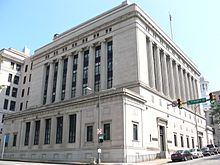
Virginia Supreme Court Building
by Dick Hall-Sizemore
The diabolical person who came up with the framework for the state constitutional amendment establishing a redistricting commission was not content with designing it so that it would fail due to partisan wrangling. He also injected partisan politics into the phase in which the state Supreme Court must come up with the plans.
If the commission cannot agree to plans to be submitted, the task falls to the Supreme Court. State law requires the Court to choose two special masters to assist it in developing the plans, one each from lists of three submitted by the leaders of each of the two political parties in the General Assembly. Among other requirements, the persons appointed by the Court shall have the “requisite qualifications and experience to serve as a special master and shall have no conflicts of interest.” The Republican list includes the following:
- Thomas Bryan, a former statistician for the U.S. Census Bureau, who founded a demographic analysis consulting firm for bipartisan clients, including expert witness services in state and local redistricting cases. He received $20,000 in consulting fees from the Virginia Senate Republican Caucus.
- Adam Kincaid, previously the redistricting coordinator for the National Republican Congressional Committee and now the executive director of the National Republican Redistricting Trust, an arm of the National Republican Committee. This is the organization former Republican Rep. Tom Davis used to draw a map of new Congressional districts for submission to the Virginia Redistricting Commission.
- Adam Foltz, who served as primary redistricting map drawer for the Wisconsin State Assembly Republican Caucus during the 2011-2012 cycle and prepared Wisconsin’s defense against court challenges. He is now a legislative analyst for the Texas Legislative Council and is working on drafting maps for that state.
The Democrat list includes:
- Bernard N. Grofman, a professor of political science at the University of California, Irvine, who served as a special master to federal courts in drawing congressional districts in 2015 and the Virginia House of Delegates districts in 2018.
- Nathaniel Persily, a professor at the Stanford Law School who has served as a court-appointed special master for state legislative and congressional maps in other states.
- Bruce E. Cain, a professor at the School of Humanities and Sciences at Stanford University who served as a court-appointed special master to draw state legislative districts in Arizona in 2002 and has been a redistricting consultant to government agencies including the Attorney General of Maryland.
As could have been predicted, partisan warfare has broken out again.
Democrats have cried foul. Sen. Richard Saslaw, D-Fairfax, the Senate majority leader, has written to the Supreme Court accusing the three special masters nominated by the Republicans as having “disqualifying conflicts of interest” and urging the Court “to reject the minority leaders’ nominees and direct them to resubmit new, unbiased nominees.”
Republicans have not responded formally to the letter, but, when the Democrats first complained publicly, the spokesman for the Republican Senate Caucus, adopting a page from the Jim Bacon playbook, dismissed the Democrats’ nominees, saying “they’re all college professors. Can you name another profession in this country that has a higher level of support for the Democratic party?”
My Soapbox
I don’t know anything about the backgrounds of the Democrats’ nominees for special master, except what I have read in press reports. They may have leanings toward Democrats; however, each one has been appointed, in the past, as a special master by a court. Presumably, those appointing courts had confidence in their integrity and ability to remain neutral in redistricting matters.
On the other hand, the Republicans were brazenly partisan with their special master nominees. It is an openly cynical approach to the Supreme Court’s role in redistricting. As the Senate Republican spokesman commented, “Neither side is going to put forward individuals that they think are not going to do a fantastic job for them.”
The Supreme Court Justices are probably saying to each other, “What did we do to deserve this?”
Here is my advice to the Court: Appoint the special masters as required by law and give them a deadline, no more than a month, to agree on maps to the submitted to you for your consideration. The Congressional districts should have first priority, because the current members of Congress should know as soon as possible what their new districts are going to look like. If the special masters fail to meet the deadline, borrow a staff member from the Division of Legislative Services who is familiar with the map-drawing software and draw the maps yourselves.
A significant number of citizens drew district maps and submitted them to the Virginia Redistricting Commission for consideration. The Commission commented on the quality of several of them. If they could do it, I have faith that you Justices could do it.


